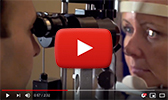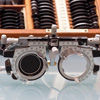Healthy vision plays an important role in childhood development, and as a parent, it is often challenging to determine whether your child's eyes are developing normally. At birth and beyond, your pediatrician checks your child's eyes for congenital (present at birth) eye diseases and developmental challenges. If there is any concern about your child's vision, a potential eye disease or vision problems due to a neurological disorder, then you will be referred to an ophthalmologist for a full examination, diagnosis and treatment if a suspected problem exists. Strabismus, amblyopia ("lazy eye"), congenital ptosis, congenital or pediatric cataracts and tear duct disorders are several eye problems that may occur during the early years of your child's eye development. If a vision or eye development problem exists, then early diagnosis and treatment is important for the best outcomes.
If no apparent vision challenges occur in the first years of life, then it is recommended that parents have their child's eyes fully examined before they enter preschool and school to ensure that any unknown vision problems do not interfere with learning. A child who is unable to see print in books or words on a blackboard can become frustrated, leading to poor performance in school. During the comprehensive eye exam, the doctor will check for:
• Near vision
• Distance vision
• Presence of astigmatism
• Binocular vision (coordination of both eyes)
• Peripheral vision (side vision)
• Eye movement skills to rule out strabismus and amblyopia
• Ability to focus on an object
• Color vision
If no vision problems exist, then it is recommended to have your child's eyes examined every two years. If your child requires glasses or contacts, then usually an annual examination is recommended to track and manage any potential changes in your child's prescription.
The doctors of Fifth Avenue Associates are highly skilled at examining, diagnosing and treating a wide range of pediatric eye diseases and disorders and will take special care to ensure the best outcomes for your child's vision.
Strabismus: Overview
Strabismus: Symptoms
Amblyopia
What is Amblyopia?
Amblyopia, or "lazy eye", is a condition in which one eye fails to develop correctly and achieve normal vision. It usually begins during infancy and early childhood, and if it is detected and treated early, then permanent visual impairment can be avoided. If left untreated, then severe visual impairment up to and including legal blindness may occur in the affected eye.
What causes Amblyopia?
In many situations, crossed-eyes (strabismus) or eye misalignment leads to amblyopia, also known as strabismic amblyopia. If your child's eyes do not focus in the same direction, then the brain will focus its efforts on one eye, leaving the other weak and unable to develop normally. If you or your pediatrician suspect strabismus, then it is important to see an ophthalmologist, as it will not go away on its own. To learn more, go to Strabismus.
Another cause of amblyopia is the presence of a cataract in one eye that prevents images from being received correctly. Thus, the brain overcompensates with the normal eye, preventing the affected eye from developing properly. To learn more, go to Pediatric Cataracts.
In some cases, the eyes are perfectly aligned and no cataract exists, but a difference in refractive error between the two eyes may be present (refractive amblyopia). For example, one eye may be nearsighted, farsighted or astigmatic while the other is normal or near normal. As a result, the brain relies on the eye with less refractive error for vision and thus the affected eye does not develop correctly. As a parent, this type of amblyopia is challenging to identify, as there are no physical signs of a problem. If you notice that your child squints, covers one eye to look at an object or exhibits compromised depth perception, then it is important to see an ophthalmologist.
What are the treatments for Amblyopia?
Treatment of amblyopia depends on the cause. If a child has strabismus or eye misalignment, then strabismus surgery to realign the eyes may be necessary. Also, eye patching and post-operative vision therapy to retrain the eye muscles may be recommended. If a cataract is present and interfering with visual development, then removal of the cataract may be necessary. Depending upon the age of the child, either an intraocular lens (IOL) will be implanted as a replacement lens, or a contact lens will be used until the child is old enough for an IOL. Refractive amblyopia can often be corrected with glasses or contact lenses that correct the refractive error of the one eye. Often an eye patch over the normal eye or atropine drops to blur the normal eye is also used to retrain the brain to rely on the affected eye.
The physicians of Fifth Avenue Associates are adept at testing for, identifying the presence of and effectively managing refractive amblyopia as well as strabismus and pediatric cataracts.
Amblyopia: Overview
Congenital Ptosis
What is Congenital Ptosis?
Congenital ptosis is defined as a drooping of one or both upper eyelids present at birth. The droop may be mild, moderate or severe to a point where the eyelids cover the pupils and impede vision. Children with moderate to severe ptosis may tilt their heads back into a "chin up" position or raise their eyebrows to compensate for the droop.
What causes Congenital Ptosis?
Congenital ptosis is often caused by poor development of the muscle responsible for lifting the eyelid, the levator muscle. Other causes may be muscular diseases, eyelid tumors or neurological conditions. If moderate to severe ptosis is left uncorrected, then the child's vision will not develop correctly, leading to permanent visual impairment and amblyopia ("lazy eye").
What are the treatments for Congenital Ptosis?
If congenital ptosis is suspected, then it is important to see an ophthalmologist for examination, as it will not resolve on its own. During the exam, the doctor will evaluate your child's vision, their need for glasses, as well as their eye movement and levator muscle strength. If the eyelid droop is mild, then treatment is often not necessary, but if it is moderate to severe, then surgery to bring the upper eyelids back into a normal position to permit normal visual development may be recommended.
If ptosis surgery is necessary, then the type of procedure will depend on the severity of the droop and the strength of the levator muscles. A procedure to tighten the muscle(s) may be performed or, if the levator muscles are extremely weak, then a procedure to suspend the muscles from the eyebrows may be the best option. The prognosis after ptosis surgery is good, but it is important to continue seeing your ophthalmologist to ensure that your child's vision develops correctly.
Conjunctivitis
What is Conjunctivitis?
"Pink Eye" (conjunctivitis), is an infection or inflammation of the conjunctiva, the clear membrane that lines the eyelid and eye. The eye(s) appear pink or red as a result of inflammation that makes capillaries in the eye more prominent. Common symptoms of pink eye are redness in one or both eyes, itchiness, discharge, irritation, crusting of the eyelashes and tearing.
What are the causes of Conjunctivitis?
Conjunctivitis in children is usually caused by bacteria, viruses, or in infants, a blocked tear duct.
What are the treatments for Conjunctivitis?
Bacterial and viral conjunctivitis are highly contagious forms of the condition. Thus children who contract it are often quickly dismissed from daycare and school until they are no longer considered contagious. Treatment for bacterial conjunctivitis includes antibiotic eye drops or ointments, and once treatment is started, the symptoms should begin to subside within a few days. It is important to finish the course of treatment prescribed to prevent recurrence of the infection. Unfortunately, there is no treatment for viral conjunctivitis, thus the virus will have to run its course allowing the symptoms to gradually clear on their own.
Pediatric Cataracts
What is a Pediatric Cataract?
A cataract is a cloudy or opaque lens of the eye, which can prevent light from reaching the retina, causing blurred or hazy vision. Cataracts in infants and children can be unilateral (in one eye only) bilateral (in both eyes) and/or congenital (present at birth). Not all cataracts in children require treatment, but if the cataract occurs in the center of the lens, then significant obstruction of vision may result and surgery may be required to prevent impaired development of vision and amblyopia.
What causes Pediatric Cataracts?
In many cases, the cause of cataracts in children is unknown, but in some, there may be a genetic link if a parent had congenital or pediatric cataracts. Congenital cataracts may also be caused by infection, diabetes, inflammation, metabolic problems or drug reactions. Often cataracts that develop in older children occur as a result of eye trauma.
How do I know if my child has a Cataract?
If your child exhibits any of the following signs and symptoms of pediatric cataracts, then an ophthalmologist should see them:
• If there is a history of congenital cataracts in your family
• You notice a white spot on your child's pupil(s)
• Your child does not respond to large or colorful objects
• Your child's eyes do not focus in the same direction
What are the treatments for Pediatric Cataracts?
While the thought of surgery may be scary for parents of children with cataracts, in some situations it is the only option to ensure proper development of vision. In fact, the earlier a visually impairing cataract is removed, the better the outcome if it develops in the first months and years of life. The first 6 weeks of life is a period of rapid visual development, thus if an infant is born with a cataract, then it is important to remove it as soon as possible. In older children, while the sense of urgency is not as high, it is still important to remove a cataract if it impedes vision in any way.
During cataract surgery, microscopic surgical techniques are used to break up the cataract and remove the lens. Then, based on the age of the child, either an intraocular lens (IOL) will be implanted as a replacement lens, or your doctor will train you how to use extended wear contact lenses and/or glasses until the child is old enough for an IOL. Once a baby grows accustomed to the contact lenses or glasses, they usually do quite well with them.
The doctors of Fifth Avenue Associates have extensive experience with cataract extraction and post surgery management of pediatric patients.
Glaucoma: Juvenile


Fifth Avenue Associates
1034 Fifth Avenue
New York, NY 10028
Phone: 212-570-0707
Fax: 212-570-0555
Email: [email protected]

Dry Eye Syndrome
Cataracts
Droopy Eyes
Bags Under The Eyes
Ptosis
Ectropion/Entropion
Eyelid Cancers
Refractive Surgery
Thyroid Eye Disease
Tear Duct Conditions
Pediatric Eye Care
Blepharospasm

For contact details and patient forms please click below.

Your gift can help Virtue Foundation tackle critical issues and make a positive impact around the globe.

Click here to view and listen to the latest Fifth Avenue Associates audio/Video Clips